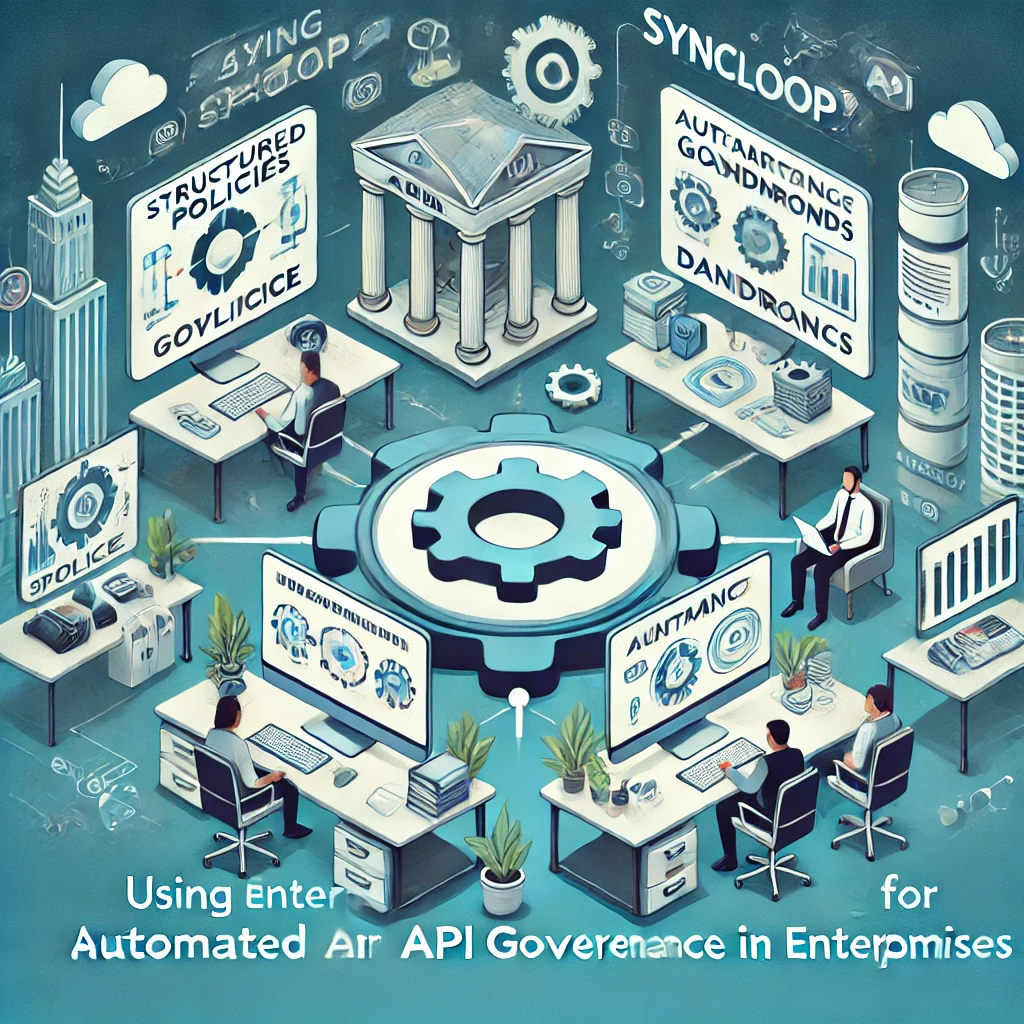Using Syncloop for Automated API Governance in Enterprises

Syncloop offers a robust platform for automating API governance, empowering organizations to enforce policies, manage security, and monitor compliance efficiently. This blog delves into how Syncloop simplifies API governance for enterprises and best practices to maximize its potential.
What is API Governance?
API governance refers to the process of defining, implementing, and enforcing standards and policies for API development, deployment, and management. It encompasses:
- Security Enforcement: Ensuring APIs are protected from unauthorized access and vulnerabilities.
- Compliance Monitoring: Adhering to regulatory standards like GDPR, HIPAA, or CCPA.
- Performance Tracking: Monitoring APIs to maintain performance benchmarks.
- Version Control: Managing API updates while ensuring backward compatibility.
- Lifecycle Management: Overseeing APIs from design to deprecation.
Effective governance helps organizations mitigate risks, optimize API performance, and maintain consistency across their API ecosystem.
Challenges in API Governance
Enterprises often face the following challenges in API governance:
- Scalability: Managing thousands of APIs across teams and departments.
- Inconsistent Standards: Varying practices in API design and implementation.
- Security Vulnerabilities: Exposing sensitive data due to weak authentication or encryption.
- Compliance Risks: Non-adherence to data privacy and industry regulations.
- Performance Monitoring: Difficulty in tracking and analyzing API performance metrics.
How Syncloop Simplifies API Governance
Syncloop provides tools and features that enable automated, scalable, and efficient API governance. Key capabilities include:
- Policy Enforcement Define and enforce governance policies for security, data handling, and usage limits across all APIs.
- Security Management Automate authentication and authorization using OAuth 2.0, JWT tokens, and role-based access controls.
- Compliance Tracking Use built-in monitoring tools to ensure APIs comply with industry and regulatory standards.
- Versioning and Lifecycle Management Manage API versions effectively, ensuring smooth transitions between updates.
- Monitoring and Analytics Gain real-time insights into API performance, usage patterns, and potential risks.
- Customizable Workflows Automate governance workflows using Syncloop’s visual tools and control structures like Ifelse and Transformers.
Steps to Implement Automated API Governance with Syncloop
Step 1: Define Governance Policies
Start by establishing clear policies for API design, security, and compliance. Examples include:
- Enforcing HTTPS for all API endpoints.
- Mandating OAuth 2.0 for authentication.
- Implementing rate limits for API usage.
Step 2: Configure Governance Rules in Syncloop
Use Syncloop’s interface to create and configure rules for:
- Authentication: Define token-based authentication methods.
- Rate Limiting: Set limits to control API traffic.
- Data Validation: Enforce schema consistency and validate incoming requests.
Step 3: Automate Monitoring
Enable Syncloop’s monitoring tools to track API performance, identify security breaches, and detect non-compliance. Configure alerts for critical metrics like latency or error rates.
Step 4: Integrate with CI/CD Pipelines
Integrate Syncloop’s governance tools into your CI/CD workflows to ensure all APIs meet governance standards before deployment.
Step 5: Optimize and Iterate
Use analytics dashboards to review governance outcomes. Refine policies and rules based on performance data and evolving business needs.
Best Practices for API Governance with Syncloop
- Standardize API Design Use Syncloop’s templates to standardize API structures and naming conventions.
- Adopt Role-Based Access Controls (RBAC) Assign roles and permissions to limit access to sensitive APIs and data.
- Enable API Auditing Leverage Syncloop’s auditing tools to maintain logs of API usage and changes for accountability.
- Implement Version Control Use Syncloop’s versioning tools to manage API updates and maintain backward compatibility.
- Automate Compliance Checks Configure automated compliance checks to avoid penalties and reputational risks.
Example Use Case: Securing Enterprise APIs with Syncloop
A financial services company wants to ensure all customer-facing APIs comply with security standards and regulations. Using Syncloop, they:
- Define Policies: Require OAuth 2.0, encrypt data in transit, and enforce rate limits.
- Automate Enforcement: Use Syncloop to apply these policies automatically to all APIs.
- Monitor Compliance: Track compliance metrics in real-time and receive alerts for violations.
- Audit Usage: Maintain logs of all API calls for regulatory audits.
Benefits of Automated API Governance with Syncloop
- Improved Security: Automated enforcement reduces the risk of human errors.
- Enhanced Scalability: Govern thousands of APIs efficiently with minimal manual effort.
- Regulatory Compliance: Stay compliant with industry standards effortlessly.
- Consistent Performance: Monitor and optimize API performance continuously.
- Cost Efficiency: Reduce governance overhead through automation.
The Future of API Governance in Enterprises
As enterprises continue to expand their digital ecosystems, the need for scalable and automated API governance solutions will grow. Syncloop equips organizations with the tools they need to stay ahead, ensuring APIs remain secure, compliant, and performant. By leveraging Syncloop, enterprises can focus on innovation while maintaining robust governance.
Image Description
A conceptual illustration showing Syncloop’s automated API governance tools in action, including security enforcement, compliance tracking, and real-time monitoring dashboards. The image highlights seamless policy enforcement across enterprise APIs.
Back to Blogs